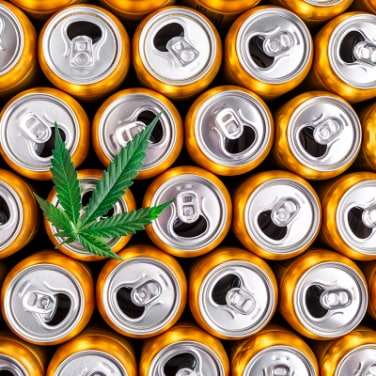Cannabis Chemistry: Mixing Buds and Beverages
By Kylie Wolfe.
The beverage section at the supermarket is constantly evolving. Even though today’s stores dedicate full aisles to different soft drinks, juices, and waters, the market is always welcoming new products. In recent years, consumers have become more concerned with health and wellness, swapping out sugary sodas for better-for-you beverages.
Alongside options with natural ingredients and fewer calories are dairy-free and plant-based alternatives. Next to those are energy and sports drinks that combine caffeine and electrolytes. Many companies have also started using more sustainable packaging. At the same time, an entirely new category is edging in — cannabis-infused beverages.
A Budding Industry
The cannabis beverage market is growing and, according to Grand View Research, is expected to be worth 2.8 billion USD by 2025. This accounts for expansion at a compound annual growth rate (CAGR) of 17.8 percent.1
As consumer interests change, several companies are stepping in to meet the demand for products in this category. In January 2021, Molson Coors introduced a line of cannabis-infused sparkling water in Colorado that’s now available in 17 other states. The product was created alongside Truss CBD, a Canada-based beverage company. In November 2021, Bedfellows Liquid Arts, also in collaboration with Truss CBD, introduced two beer-inspired yet non-alcoholic cannabis beverages in Canada. Lagunitas also launched in this space with a zero-calorie, zero-carb option.2
"It’s that much easier to get into people’s hands and to incorporate as part of their life and routine."
“There are so many benefits to cannabis use and if we can package it in something that’s already been socially ritualized, like a drink, it’s that much easier to get into people’s hands and to incorporate as part of their life and routine,” said Ted Whitney, vice president of sales and marketing at Pacific Stone, a California-based cannabis company.
Cannabis Chemistry
Cannabidiol, or CBD, is a non-psychoactive chemical found in the cannabis plant. It can be used to treat anxiety and depression, stress, and inflammation, making it an attractive ingredient for health-focused consumers. That’s where the beverage industry sees an opportunity.
But creating a cannabis-infused beverage is an involved chemical process. Bioactive compounds like terpenoids, flavonoids, and in this case, cannabinoids, aren’t very soluble, and that’s a challenge for manufacturers.3
“Cannabis extract is an oil that’s inherently hydrophobic, so to get it to stay in solution is really challenging. Right now, the dominant paradigm is to put it into a nanoemulsion. You make little, tiny oil droplets and suspend them in water, but it’s not super stable,” said Whitney.
For example, after 90 days, the emulsion can fall apart and produce sediment. Because of the way cannabinoids are incorporated into an aqueous solution, they can also be less bioaccessible.
“The chemistry of cannabis is just not water friendly,” he said. “Even when it goes into solution, your body doesn’t absorb cannabis the same way without fats to encapsulate it.”
"Creating a cannabis-infused beverage is an involved chemical process."
Because the demand for cannabis-infused beverages is expected to rise, a result of more widespread consumer acceptance, there's not only a greater need for manufacturing solves, but for quality control and safety testing.
Navigating a New Category
Though legal in Canada, only a few states permit the sale of CBD-infused beverages, so navigating regulatory hurdles is also part of the process. But as the industry continues to grow, it should become easier to bring these products to market. For example, advancements in technology would help manufacturers better incorporate cannabinoids in drinks.
“Beverage consumption is something we’ve really normalized for people. They’re very comfortable unwinding from work and cracking a beverage,” said Whitney, who’s also experienced in the craft beer space.
Even though there are still challenges to overcome, including plenty of social stigmas, industry professionals are ready to bring a new category to passionate consumers — and some are already doing so.
Kylie Wolfe is a Thermo Fisher Scientific staff writer.
References
1. No author listed. (January 2020). Cannabis Beverages Market Growth & Trends. Grand View Research. https://www.grandviewresearch.com/press-release/global-cannabis-beverages-market
2. Shoup, Mary Ellen. (November 2021). Molson Coors-backed Veryvell CBD sparkling water gains steam in evolving market. Food Navigator USA. https://www.foodnavigator-usa.com/Article/2021/11/22/Molson-Coors-backed-Veryvell-CBD-sparkling-water-gains-steam-in-evolving-market
3. No author listed. Accessed March 2022. The Art and Science of Cannabis Beverages. Le Herbe. https://www.newcannabisventures.com/wp-content/uploads/white_paper_ascb_v9.pdf
